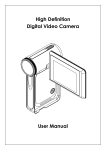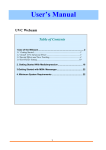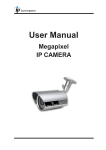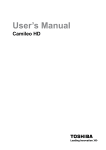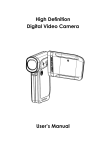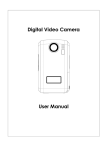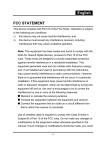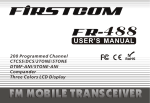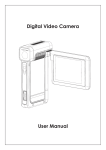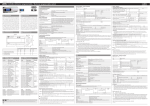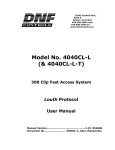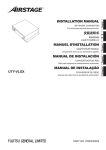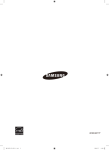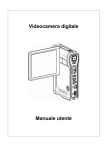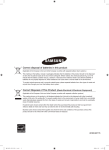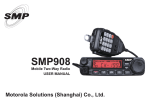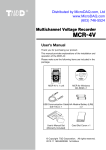Download User Manual - B&H Photo Video Digital Cameras, Photography
Transcript
High Definition Digital Video Camera User Manual Contents Section 1 Getting to Know Your Camera............................................. 2 Section 2 Getting Started...................................................................... 5 Section 3 Record Mode......................................................................... 7 Section 4 Playback Mode................................................................... 27 Section 5 Listening to MP3 Music...................................................... 37 Section 6 Viewing Movie on PC......................................................... 40 Section 7 Viewing Pictures and Movies on a TV.............................. 41 Section 8 Video File Converter ......................................................... 43 Section 9 Burning the Recorded Clip into DVD................................ 47 Section 10 Uploading Video Files to YouTube.................................... 49 Section 11 Transferring Data to Computer......................................... 52 Section 12 Specifications and System Requirements....................... 54 1 Section 1 Getting to Know Your Camera Overview The camera with 5 Mega Pixel sensor can take H.264 movies. By way of using H.264 technology, more videos can be taken within certain amount of memory. High quality images with up to 11 mega-pixels can also be delivered smoothly. With a color LCD monitor, users can compose images and examine them easily. The Camera also features movie recording at HD resolution of 1280x720. You can also connect DV to a HDTV by HDMI cable, and easily playback recorded high-definition videos on the wide screen of an HDTV. Exposure and color balance can either be adjusted automatically or allowed to be changed manually. An 8x digital zoom increases user control over the movies and pictures you take. The camera is also ideally suited for using as a PC camera hooked up to your computer via high speed USB 2.0 port. Biult-in memory allows you to take pictures and movies without memory card. The memory card slot allows users to increase the storage capacity. Note Partial memory of the built-in memory is used for Firmware code. Standard Accessories Unpack the package and make sure all standard accessories listed are included: • Camera • USB Cable • AV Cable • HDMI Cable • Adaptor • Lithium-ion Rechargeable Battery • Quick Guide • CD-ROM (Driver, ArcSoft Software and User Manual) • Earphone • Strap • Pouch 2 Front View Marco Switch Lens Light LCD Panel Power Button Rear View Movie Shutter Button Picture Shutter Button Tele Button (Up Button) OK Button Wide Button (Down Button) Right Button Left Button RECORD/PLAY Button TV/Earphone Port Mini USB 2.0 port HDMI Port 3 Side View Speaker Microphone Battery Cover 4 Section 2 Getting Started Loading the Battery Before using the camera, users must load NP 60 Battery. 1.Follow the arrow direction and slide to eject the battery cover. 2.Insert the battery according to the correct polarity marks ( + or -). Eject 3.Close the battery cover firmly. Inserting and Removing an SD Card (Optional) The camera comes with internal memory which allows you to store pictures, movies and music. You can expand the memory capacity by using an optional SD memory card. To insert a memory card, refer to the figure as below: 1.Insert the memory card into the right position. 2.To remove an installed SD card, press the card inwards to release it. 3.When the card pops out, gently remove it from its slot. Note When a memory card is fitted, movies and pictures are saved on card rather than on the built-in memory. 5 Protecting Data on an SD Card SD card is read-only by locking the SD card. No pictures and movies can be recorded when the SD card is locked. Make sure the lock is on writeable position before recording. Writeable position Write-Protected Position Turning the Camera On and Getting Started To turn on the camera: 1.Flip out the LCD panel; the camera will turn on automatically. 2.Or press Power Button for one second to turn on it. 90。 90。 • To take a movie, press the Movie Shutter Button ( ). • To take a picture, press the Picture Shutter Button ( ). • To take movie at HD resolution, press Right Button to switch to HD mode, then press the Movie Shutter Button ( ). • To view stored movies, pictures, listen to stored MP3, press RECORD/PLAY Button ( ) once to switch to Playback Mode. Press a second time to return to Record Mode. Turning the Camera Off To turn off the camera, you can either press the Power Button for one second, or you can place the LCD panel back to its original position. 6 Section 3 Record Mode Button Function Right Button: HD Mode Left Button: Light ON / OFF Tele Button (Up Button): Digital Zoom In Wide Button (Down Button): Digital Zoom out OK Button: Menu ON Power Button: Press down for one second to turn on or turn off the camera. RECORD/PLAY Button functions: 1.Switch between Record /Playback Mode. 2.Return to the previous page. 3.Quick review Movie Shutter Button: 1.Start to take movie. 2.To stop recording, press it again. Picture Shutter Button: Start to take picture. Macro switch: Switch between Macro Mode and Normal Mode. 7 LCD Monitor Information The indicator shows below may display on LCD when movies and pictures are recorded: Record Mode Movie Record Mode Picture Record Mode Stabilization Scene Mode Night Mode Backlight Mode Resolution (1) Movie: Picture: (2) HD HD / D1 High / D1 / VGA / Standard/ SD card inserted (4) Macro Position Focusing (5) White Balance Battery indicator: full power / (7) Light on (8) Selftimer enabled (9) (10) Low Number of images or recording time of movie that can still be taken at current resolution. (3) (6) QVGA medium power / 8X digital zoom Motion Detection 8 low power / power empty (11) Intelligent Lighting On H.264 Movie Recording Press Movie Shutter button ( ) to start recording. When a movie is recording, a time indicator will display on LCD monitor. To stop recording, press Movie Shutter Button ( PLAY Button to view the recorded movie. Four resolution settings are available: Quality HD HD D1 D1 VGA QVGA Picture Recording Press the Picture Shutter Button ( ) to take a picture. Press RECORD/PLAY Button to view the picture. Three resolution settings are available: Image Quality High Quality Standard Quality Low Quality 9 ) again. Press RECORD/ Taking Close up Pictures The Macro Mode ( ) should be used for object located at about 20 cm. To take close-up pictures: 1. Slide the macro switch to Macro ( ) positions. In Macro Mode, the macro icon ( ) will appear on the LCD monitor. 2.Press Picture Shutter Button ( ) to take the picture. Note Remember to turn the macro switch back to Normal ( pictures. ) when you are not taking close-up Using Digital Zoom The digital zoom magnifies images, when recording movies or taking pictures. 1.To zoom in/out, press the Tele/Wide Button. 2.The digital zoom can be set from 1x to 8x. 10 Options for Record Menu Movie Mode Camera Mode Smart Function Effect Setting • Resolution • Resolution • Intelligent Light • Scene Mode • Sound • Stabilization • Selftimer • Motion Detect • Exposure • Information • Light • Exit • Exit • White Balance • Time Setting • Exit • Format • Exit • TV System • Language • Default Setting • Exit Operations for Record Mode Operation Screen 1.Press OK Button when in Movie/Picture Record Mode. 2.Use Right/Left Buttons to move between main menu options, which are Movie Mode, Camera Mode, Smart Function, Effect, and Setting. Submenu will pop out while move to each main option. 3.Press OK Button to validate sub option you select. 4.Select Exit option to exit submenu. 11 Enter Button Default Setting and Validation The following table indicates the camera’s default setting as well as its validation. 1.Always: The setting always keeps valid. 2.One Time: The setting is only valid either once or till camera power off. Validation Resolution Always Default Factory Setting VGA for Movie Standard for Picture Exposure One Time 0EV White Balance One Time Auto Stabilization Always Off Motion Detect One Time Off Light Always Off Selftimer One Time Off Scene Mode One Time Auto Sound Always On Format One Time Off TV System Always Depends on shipping area Language Always Depends on shipping area Volume Always Level 6 Information One Time On Intelligent Light One Time Off 12 Movie Mode submenu Setting Record main menu includes camera setting and other advanced setting. You can use Right/Left Buttons to move between options and press OK Button to validate the setting. Movie Resolution To change Movie Resolution: 1.In Movie/Picture Record Mode, press OK Button to switch to record menu screen. 2.Use Right/Left Buttons to select Movie Mode. Submenu of Movie Mode will pop out on the screen. 3.Use Up/Down Buttons (Tele-Wide Buttons) to select Resolution then press OK Button to switch to Resolution submenu. 4.Use Up/Down Buttons to move between four settings. 5.Press OK Button to validate the setting and exit. Display Screen Video Resolution Option OK Button 13 Stabilization To enable Stabilization: 1.In Movie/Picture Record Mode, press OK Button to switch to record menu screen. 2.Use Right/Left Buttons to select Movie Mode. Submenu of Movie Mode will pop out on the screen. 3.Use Up/Down Buttons (Tele-Wide Buttons) to select Stabilization then press OK Button to switch to Stabilization submenu. 4.Use Up/Down Buttons to choose ON or OFF. 5.Press OK Button to validate the setting and exit. Display Screen Stabilization Option OK Button Note • The captured screen will be smaller when Stabilization is enabled. • Digital Zoom is disabled when Stabilization is activated. 14 Light To change Light setting by either hot key (Left Button) or Option Setting. • Light On ( ): LED keeps on to add light during the low light environment. • Light Off : Disable Light-On function. To change Light setting: 1.When in Movie Mode, use Up/Down Buttons (Tele-Wide Buttons) to select Light Option, then press OK Button to switch to Light submenu. 2.Use Up/Down Buttons (Tele-Wide Buttons) to choose ON or OFF. 3.Press OK Button to validate the setting and exit. Note The Light will be disabled automatically when battery power is low ( Display Screen ). Light Options OK Button 15 Camera Mode Setting Picture Resolution To change Picture Resolution: 1.In Movie/Picture Record Mode, press OK Button to switch to record menu screen. 2.Use Right/Left Buttons to select Camera Mode. Submenu of Camera Mode will pop out on the screen. 3.Use Up/Down Buttons (Tele-Wide Buttons) to select Resolution then press OK Button to switch to Resolution submenu. 4.Use Up/Down Buttons to move between three settings. 5.Press OK Button to validate the setting and exit. Display Screen Video Resolution Option OK Button 16 Selftimer (Picture Record Mode Only) The Selftimer allows you to take pictures with a ten-second time delay. The selftimer light on the front of the camera will also blink. The speed of blinking will increase just before the picture is taken. To enable Selftimer: 1.When in Camera Mode, use Up/Down Buttons (Tele-Wide Buttons) to select Selftimer, then press OK Button to switch to Selftimer submenu. 2.Use Up/Down Buttons to choose ON or OFF. 3.Press OK Button to validate the setting and exit. Display Screen Selftimer Options OK Button 17 Smart Function Smart Function menu includes Intelligent Light and Motion Detect. You can use Right/Left Buttons to move between options and press OK Button to validate the setting. Intelligent Light To enable Intelligent Light: 1.In Movie/Picture Record Mode, press OK Button to switch to record menu screen. 2.Use Right/Left Buttons to select Smart Function Mode. Submenu of Smart Function Mode will pop out on the screen. 3.Use Up/Down Buttons (Tele-Wide Buttons) to select Intelligent Light then press OK Button to switch to Intelligent Light submenu. 4.Use Up/Down Buttons to choose ON or OFF. 5.Press OK Button to validate the setting and exit. Display Screen Intelligent Light: Option OK Button 18 Motion Detection To enable Motion Detection: 111In Movie/Picture Record Mode, press OK Button to switch to record menu screen. 222Use Right/Left Buttons to select Smart Function Mode. Submenu of Smart Function Mode will pop out on the screen. 333Use Up/Down Buttons (Tele-Wide Buttons) to select Motion Detect then press OK Button to switch to Motion Detect submenu. 444Use Up/Down Buttons to choose ON or OFF. 555Press OK Button to validate the setting and exit. 666Camera will start to record video once if there is a movement for 3 consecutive seconds. Stop recording if there is no movement for 3 seconds. Motion Detect Option Display Screen OK Button 19 Effect Setting There are 3 modes which are Scene Mode, Exposure, and White Balance. Scene Mode To enable Scene Mode: 111In Movie/Picture Record Mode, press OK Button to switch to record menu screen. 222Use Right/Left Buttons to select Effect Setting. Submenu of Effect Setting Mode will pop out on the screen. 333Use Up/Down Buttons (Tele-Wide Buttons) to select Scene Mode then press OK Button to switch to Scene Mode submenu. 444Use Up/Down Buttons to move between 6 settings. 555Press OK Button to validate the setting and exit. Display Screen Scene Mode Option OK Button 20 Exposure The camera adjusts image exposure automatically. In certain circumstances you may wish to adjust the exposure compensation setting. To change Exposure setting: 111In Movie/Picture Record Mode, press OK Button to switch to record menu screen. 222Use Right/Left Buttons to select Effect Setting Mode. Submenu of Effect Setting Mode will pop out on the screen. 333Use Up/Down Buttons (Tele-Wide Buttons) to move to Exposure Option. Press the OK Button and then Exposure Submenu will pop out on the screen. 444Use Up/Down Buttons to choose preferred EV value. The change can be previewed immediately. 555Press OK Button to validate the setting and exit. Display Screen Exposure Option OK Button 21 White Balance The camera adjusts the color balance of images automatically. Three manual white balance settings are available: • Auto (Default): The camera automatically adjusts white balance. • Daylight: Under outdoors. • Fluorescent: Under fluorescent light condition. • Tungsten: Under tungsten light condition. To change White Balance Setting: 1.In Movie/Picture Record Mode, press Ok Button to switch to record menu screen. 2.UUse Right/Left Buttons to select Effect Setting Mode. Submenu of Effect Setting Mode will pop out on the screen. 3.Use Up/Down Buttons to select White Balance, then press OK Button to switch to White Balance submenu. 4.Use Up/Down Buttons to move between four settings. The change can be previewed immediately. 5.Press OK Button to validate the setting and exit. Display Screen W/B Option OK Button 22 Setting Menu The Setting submenu contains options for configuring your camera set up. To change advanced setting: 1.In Movie/Picture Record Mode, press OK Button to switch to record menu screen. 2.Use Right/Left Buttons to move to Setting option, then Setting Submenu will pop out on the screen. 3.Use Up/Down Buttons (Tele-Wide Buttons) to move between settings. Display Screen Setting Option • Sound (operation sound) • Information • Time Setting • Format • TV System • Language • Default Setting Sound Setting Enable or disable KeyPad tone and operation sound by using Up/Down Buttons (Tele-Wide Buttons) , the press OK Button to validate the setting. Submenu Display Screen Sound Setting Sound 23 Information On: Show the indicator(s) on the LCD screen. Off: Do not show the indicator(s) on the LCD screen. Submenu Display Screen Information Information Time Setting • Move between Date, Time, Set and Exit by using Left/Right Buttons. • Adjust date and time by using Up/Down Buttons, then select Set to validate each change. • Select Exit to leave Time Setting without any change. Submenu Display Screen Time Setting Time Setting 24 Format Submenu Display Screen Format Options Format Yes: Format the SD Card / built-in memory. No (Default): Do not format SD Card / built in memory. Note All the data will be erased if the SD card is formatted. Make sure all the data are duplicated to PC before formatting SD card. TV System Ensure that the appropriate TV standard of your area is selected – either NTSC or PAL. Wrong TV system setting may cause image flicker. NTSC standard: USA, Canada, Japan, South Korea and Taiwan etc. PAL standard: UK, Europe, China, Australia, Singapore and Hong Kong etc. Submenu Display Screen TV System Option TV System 25 Selecting Interface Language Submenu Display Screen Language Default Setting To restore the default factory setting, select this option. Submenu Display Screen Default Setting Option Default Setting 26 Section 4 Playback Mode Press RECORD/PLAY Button to switch from Record Mode to Playback Mode. The Playback Mode is for viewing and managing movies and pictures as well as listening to music on the built-in memory or on an optional memory card. Operation Display Screen ) to switch Press RECORD/PLAY Button ( from Record Mode to Playback Mode Main Menu. • There are 3 options in the Playback Mode, movie, picture and music. • Direction Buttons can be used to select the specific option. • Press OK Button to view movies/pictures or listen to music. Button Function The Direction Buttons have the following functions in Movie and Picture Playback Modes. Right Button: Go to the next movie/picture/Music. Left Button: Go to the previous movie/picture/Music. Tele Button (Up Button): Digital Zoom in. Wide Button (Down Button): Digital Zoom out. OK Button: Enter to movie, picture or music option menu. RECORD/PLAY Button functions: 1.Switch between Record and Playback modes. 2.Return to the previous page. Movie Shutter Button: Start playing the recorded movie. 27 LCD Monitor Information Indicators on the LCD screen while in Playback Mode: Movie resolution Indicator HD HD Resolution D1 D1 Resolution VGA (1) QVGA Picture Resolution Indicator High Resolution Standard Resolution Low Resolution Indicate the selected movie/picture is locked. Indicate the single movie/MP3 is being repeated. (2) Indicate all of the movies/MP3 are being repeated. Indicate the slide show is playing. (3) (4) Current Number/ Total number of movie, picture, or MP3. Magnification Indicator. 28 Movie Playback Operation Display Screen 1.Use Direction Buttons to select the Movie option. 2.Press OK Button to go to Movie Playback Mode. 3.Use Right/Left Buttons to go to the next or last movie. 4.Press Movie Shutter Button to play and press it again to pause. 5.While playing movie, press Right/Left Buttons to fast forward/backward, then release the button to stop. 6.Use Up/Down Buttons to adjust volume. 7.Press OK Button to go to the movie option menu. 8.Use Right/Left Buttons to select six options, Delete, Thumbnail, Lock, Repeat One, Repeat All, or Exit. 29 Delete Movies Operation Display Screen 1.Use Right/Left Buttons to select the Delete option ( ). 2.Press OK Button to go to the Delete menu. 3.Use Right/Left Buttons to select the movie. 4.Use Up Button to delete all movies and Down Button to delete single movie. 5.Before a movie is deleted, a confirmation screen will appear; choosing “Yes” will execute the operation and “No” to cancel the operation. 6.Press OK Button to exit. Note • If a memory card is fitted, you can delete only those movies stored on the card. • Movies on a written-protected memory card cannot be deleted. • The delete function will only erase unlocked movies. Locked movies must be unlocked before being deleted. 30 Thumbnail Function Operation Display Screen 1.Use Right/Left Buttons to select the Thumbnail option ( ). 2.Press OK Button to view nine thumbnail movies. 3.To play a movie, use Right/Left Buttons to select the movie and press OK Button to view. Lock Movies Single or all movies can be locked. This function can prevent the movies from being deleted accidentally. Operation Display Screen 1.Use Right/Left Buttons to select the Lock option ( ). 2.Press OK Button to go to the Lock menu. 3.Use Right/Left Buttons to select the movie. 4.Use Up Button to lock/unlock all movies and Down Button to lock/unlock single movie. 5.Before a movie is locked/unlocked, a confirmation screen will appear; choosing “Yes” will execute the operation, “No” will cancel the operation. 6.Press OK Button to exit. 31 Repeat Movies This function automatically repeats playing single movie or all movies in order. Operation Display Screen 1.Use Right/Left Buttons to select the Repeat One ) or Repeat All option ( ). option ( 2.Press OK Button to start repeating. 32 Picture Playback Operation Display Screen 1.Use Direction Buttons to select the Picture option. 2.Press OK Button to go to Picture Playback Mode. 3.Use Right/Left Buttons to go to the next or last picture. 4.While the picture is selected, use Up/Down Buttons (Tele/Wide Buttons) to magnify. 5.To navigate the magnified picture, press OK Button to enter navigation mode. Use Direction Buttons to navigate the magnified picture. Press OK Button again to exit navigation mode. 6.Press OK Button to go to the picture option menu. 7.Use Right/Left Buttons to select five options, Delete, Thumbnail, Lock, Slideshow, or Exit. 33 Delete Picture Operation Display Screen 1.Use Right/Left Buttons to select the Delete option ( ). 2.Press OK Button to go to the Delete menu. 3.Use Right/Left Buttons to select the picture. 4.Use Up Button to delete all pictures and Down Button to delete single picture. 5.Before a picture is deleted, a confirmation screen will appear; choosing “Yes” will execute the operation, “No” will cancel the operation. 6.Press OK Button to exit. Note • If a memory card is fitted, you can delete only those pictures stored on the card. • Pictures on a written-protected memory card cannot be deleted. • The delete function will only erase unlocked pictures. Locked pictures must be unlocked before being deleted. 34 Thumbnail Function Operation Display Screen 1.Use Direction Buttons to select the Thumbnail option ( ). 2.While selecting Thumbnail option, press OK Button to view nine thumbnail pictures. 3.To view a picture, use Direction Buttons to select the picture. 4.Press OK Button to view the selected picture. Lock Pictures Single or all pictures can be locked. This function can prevent the pictures from being deleted accidentally. Operation Display Screen 1.Use Right/Left Buttons to select the Lock option ( ). 2.Press OK Button to go to the Lock menu. 3.Use Right/Left Buttons to select the picture. 4.Use Up Button to lock/unlock all pictures and Down Button to lock/unlock single picture. 5.Before a picture is locked/unlocked, a confirmation screen will appear; choosing “Yes” will execute the operation, “No” will cancel the operation. 6.Press OK Button to exit. 35 Make Slide Show This function automatically repeats all pictures in order. Operation Display Screen 1.Use Right/Left Buttons to select the Slide option ( ). 2.Press OK Button to start the slide show; press it again to stop. 36 Section 5 Listening to MP3 Music MP3 Music MP3 is a compressed audio file format. The MP3 music can be downloaded from some MP3 web sites. Transfer MP3 Music to the camera 111Install the camera driver on your computer. 222Connect your camera to the computer USB port. 333The Red LED will light when the camera is connected to the computer and in Mass Storage Mode. 444Transfer MP3 music to My Computer\Removable Disk\MP3. 555Once all the music is transferred, disconnect the USB cable from the PC. 37 Listen to MP3 Music Operation Display Screen 111In Playback Mode, use Right/Left Buttons to select the Music option. 222Use Up/Down Buttons to locate MP3 you want to play, or press Right/Left Buttons to jump to the next/previous page. 333Press Movie Shutter or OK Button to play MP3. 444Press Movie Shutter Button again to stop playing. 555Press Up/Down Buttons to adjust volume. 666Press OK Button to go to repeat menu. 777Press Down Button once to repeat current MP3 ( ). 888 Press Down Button twice to repeat all MP3 ( ). 999Press OK Button to exit. 38 Listen to MP3 Music with earphone MP3 stored in the camera can be played either by built-in speaker, or Earphone, or TV. When the earphone cable is plugged in the camera, the option menu of Earphone/TV pops out on the LCD Screen. Choose earphone or TV and press OK Button to validate the setting. 39 Section 6 Viewing Movie on PC View Movie on PC When playing a movie for the first time, Video Codec should be installed in PC. To do this: 1.Insert the CD-ROM into the computer’s CD-ROM drive. Click “Install Device Driver” and follow the on-screen instructions to complete the installation. 2.Start video player such as Widows Media Player to view AVI Movies. Share Movie You can share the recorded movies to your friends via internet or CD. Make sure Video Codec is installed in your friends’ PC. Video Codec is available in the provided CD. 40 Section 7 Viewing Pictures and Movies on a TV Connecting to a high-definition TV 1.Connect HDMI cable to a HD TV. 2.Set video input source of a TV to “ HDMI” option. 3.The steps for viewing stored pictures and movie on a TV are exactly the same as for viewing them on the LCD monitor. 41 Connecting to a non-high-definition 16:9 (Wide) or 4:3 TV 1.Connect one end of the AV cable to your camera’s AV Out port. 2.Connect the other end of the cable to a television. 3.The option menu of Earphone/TV pops out on the LCD Screen. 4.Choose TV option and press OK Button to validate the setting. 5.The steps for viewing stored pictures and movie on a TV are exactly the same as for viewing them on the LCD monitor. Note The LCD Panel does not work when the camera is connected to a television. 42 Section 8 Video File Converter Bundled software CD contains ArcSoft MediaConverter that features video file converter to convert multiple video formats into compatible format with your camera. In this way, you can convert various video files formats and playback your favorite movies on your camera. MediaConverter To convert a video file: 1.Install ArcSoft MediaConverter ( Refer to section 11). 2.Click [ Start ] g [ Select Programs ] g [ ArcSoft MediaConverter ] g [ MediaConverter] . 3.MediaConverter main Screen will appear on your desktop. 4.Click [ Add File] . 43 5.Select Video file you want to convert. 44 6.You can preview your media files before converting. To preview media files, use the following control functions. • Click to start previewing. • Click to stop previewing. Make sure your media files can be previewed before converting. 45 7.Click on [ Start ] to begin converting files. 8.Task Report window will pop out after the task is completed. 9.Before transferring the converted file to your camera, rename the converted file to “ Clip0001.avi”. (Please note: if Clip0001.avi exists in the camera, then the converted file has to be renamed to clip0002.avi) 10.Connect your camera to PC and transfer the converted video to “My Computer\Removable Disk\ DCIM\200Movie” in your camera. (Refer to Section 11 Transferring Data to a Computer.) 11.After transferring the converted video to the camera, press RECORD/ PLAY button and select PLAYBACK mode to enjoy your favorite movie. 46 Section 9 Burning the Recorded Clip into DVD Bundled software CD contains ArcSoft MediaImpression also featuers burning the movie clip into DVD. You can preserve your precious movies on DVD to share with family and friends. To create a DVD: 1.Install ArcSoft MediaImpression (Refer to Section 11) 2.Click [ Start ] g[ Select Programs ] g[ ArcSoft MediaImpression ] 3.ArcSoft MediaImpression main Screen will appear on your desktop. 4.Click [ Make Movie ]. 47 1 2 3 4 5.Click [ Start ] to start DVD burning. 48 Section 10 Uploading Video Files to YouTube The bundled software CD contains ArcSoft MediaImpression which features uploading the recorded videos to YouTube. It will help you can share them with your family and friends on YouTube website. Also bundled Youtube-Link software inside camera which allows uploading your favorite video to Youtube web site easily. ArcSoft MediaImpression To upload video files to YouTube: 1.Install ArcSoft MediaImpression (Refer to Section 11) 2.Click [Start] g [ Select Programs ] g [ ArcSoft MediaImpression ] 3.ArcSoft MediaImpression main Screen will appear on your desktop. 4.Click [ Video] Option. 49 5.Select the video file you want to upload and click [ Upload to YouTube] option at the bottom menu. 50 6.Fill in your YouTube account information in the blanks, and then click on [Login] 7.Fill in the information of the video clips in the blanks, and then click on [Upload] 51 Section 11 Transferring Data to Computer Installing the Digital Camera Driver Before connecting this camera to a computer for the first time, you should install a driver on the computer. The driver is on the CD-ROM disc provided in the package. To install the driver: 1.Insert the CD-ROM into the computer’s CD-ROM drive. The autorun screen will appear. 2.Click “Install Device Driver”. Follow the on-screen instructions to complete the installation. Depending on your operating system, you may have to restart your computer after installing the driver. Connecting Your Camera to a Computer You can transfer pictures and movies stored on your camera to a computer and send them in emails to friends or post them on websites. To do this you should: 1.Connect the computer and camera with the supplied mini USB 2.0 cable. 2.Default mode is Mass Storage Mode when the camera connects to PC. 3.Mass Storage Device mode is the Default mode, when camera is connected to computer. 4.You can transfer / drag movies, pictures, MP3 songs, data files from computer to your camera, or from camera to computer. Make sure you transfer data to the proper folder; MP3 songs to the MP3 folder, for example. Mass Storage Device Mode The RED LED will light up when the camera is connected to the computer. Movies and pictures can be found on your computer at “My Computer\Removable Disk\DCIM\”. Under this mode, you can read, delete, move, or copy any movie/picture you want. Use the bundled ArcSoft application software to edit the movies or pictures. PC Camera Mode When in Mass Storage Device Mode, press RECORD/PLAY Button to switch to PC Camera Mode and the GREEN LED will light up. Under this mode, you can implement live video conference meetings or use video email over the Internet. 52 Installing Bundled Software The CD-ROM supplied with this camera contains 4 pieces of software. • ArcSoft MediaImpression is a user-friendly application that helps you read, edit and organize images, video and MP3 files. • ArcSoft MediaConverter can convert multiple video formats into compatible format for using on your camera. • Adobe Reader is a popular program that you need to have installed to read the User’s Manual. Many computer users will find they already have this software installed on their computer. • Device Drivers include : (1) Video Codec for viewing movies correctly on PC (2) Webcam Driver The detailed information can be found in online help of all the bundled software. To install the bundled software: 1.Insert the CD-ROM into your computer’s CD-ROM drive. The autorun screen appears. 2.Select the software application you want to install from the list, then click Install Application Software. Follow the on-screen instructions to complete the installation. 53 Section 12 Specifications and System Requirements Specification Image Sensor 5 Mega Pixel Sensor Operation Modes Movie Record, Picture Record, MP3 Player, PC Camera, Mass Storage Device Lens F3.2 (f = 7.2mm) Focus Range 200cm~infinite (Normal Mode) Center: 20 cm (Macro Mode) Digital Zoom 8X Shutter Electronic LCD monitor 2.5”LCD Storage Media Built-in 64M Memory (partial memory is used for Firmware code); SD Card Slot support Image Resolution Still image 3744x2808 (11M Pixels) 2592x1944 (5M Pixels) 1600x1200 (2M Pixels) Movie Resolution HD 1280 x 720 pixels 30 fps D1 720 x 480 pixels 30 fps VGA 640 x 480 pixels 30 fps QVGA 320 x 240 pixels 30 fps White Balance Auto/Manual (Daylight, Fluorescent, Tungsten) Exposure Auto/Manual Selftimer 10 second delay Light Light On/Off File Format Picture: JPEG Movie: AVI (H.264) Music: MP3 Image play Single Image/Thumbnails/Slideshow PC Interface Mini USB 2.0 Port TV out NTSC/PAL Selectable Battery Lithium-ion Rechargeable Battery Dimension 100(H) * 57(W) * 17.9(D) mm Weight 86g (without battery) 54 System Requirement Windows 2000/XP/Vista Pentium III 800 MHz above 256 MB RAM CD ROM 1GB free HDD space Available USB port 16-bit Color Display Note The LCD screen is manufactured using extremely high-precision technology so over 99.99% of the pixels are operational for effective use. Hoever, some tiny black and/or bright dots (white, red, blue or green) may appear on the LCD screen. These dots are a normal result of the manufaturing process, and do not affect the recording. 55
























































